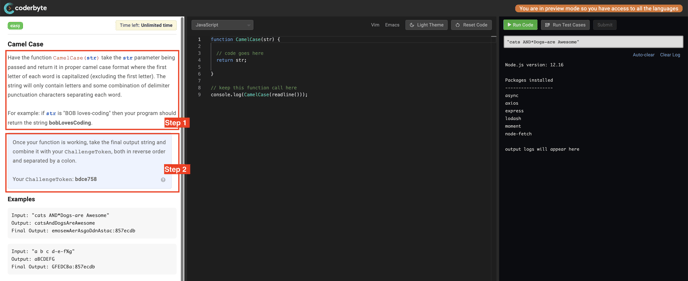Cheat-proof challenges to prevent candidates from copying solutions online
Ensure that every challenge solution is 100% unique
Overview
Coderbyte's cheat-proof technology is an innovative approach to combatting solution sharing, inspired by spam-detection technology like CAPTCHA. Cheat-proofing adds a unique modification to every challenge to ensure that the must write a 100% unique solution that cannot be found online.
Note: Our approach is becoming an increasingly popular and proven technique. The College Board recently deployed a similar technology to ensure that every SAT exam is unique in order to prevent cheating.
Cheat-proofing is available in addition to Coderbyte's industry-leading array of cheating prevention capabilities:
- Tracking copy and pasted code in the editor
- Letting you know when candidates leave the tab
- Masking challenge titles so candidate can't easily research challenges beforehand
- Comparing candidate solutions to those stored in Coderbyte's database
While Coderbyte will catch if a candidate finds a challenge solution online and pastes the code into the editor, it's still possible for a candidate to rewrite the solution line-by-line after looking at the solution on another computer or mobile device.
A common approach that other technical screening platforms use is to randomize the challenge sets per candidate, but this introduces significant bias into the assessment. Some candidates may get slightly easier or more difficult challenges than others, no matter how similar those challenges may seem on the surface.
Cheat-proof challenges
Coderbyte is the first platform to eliminate the ability to copy solutions found online by introducing an output modification to a challenge that makes the solution 100% unique.
The output modification incorporates the candidate's unique ID to generate a second step to a challenge's instructions. The second step isn't technically challenging, so an honest candidate who knows how to code will solve it easily with 4 to 7 lines of code. But because it is 100% unique, a cheater will not be able to find a solution online to solve it.

Even if a candidate can find the exact code for the first step of a challenge, the second step will prevent the solution from working without a technical modification. If candidates know how to code, then it should take no more than 5 minutes to implement this final step, and it shouldn't be more than 4-7 lines of code.
See it in action
Below is a demonstration of what happens when a candidate copies and pastes a solution from the internet. The solution that's hosted on GitHub should produce a perfect score and pass all the test cases, but as you can see the test cases fail because of the extra output requirement that needs to be implemented by the candidate.
Turning the feature on for your screening assessment
First, hit Edit on any Assessment and then navigate to your assessment's (1) Settings. Next, find the (2) Cheating prevention header and select Yes on the setting to cheat-proof eligible challenges.

When selecting challenges for your assessment, filter by cheat-proof challenges.

Cheat-proof challenges will have a spy icon next to them to indicate that they require a 100% unique solution that cannot be found online.

Note: When candidates anticipate the ability to cheat but are thwarted, they often make false claims. For example, they may complain that they have not received the assessment invite or say that the code editor was glitchy. With cheat-proofing, you should expect an increase in such complaints. However, the easiest way to demonstrably prove these claims false is to see any examples of candidates who can code performing well on the assessment.